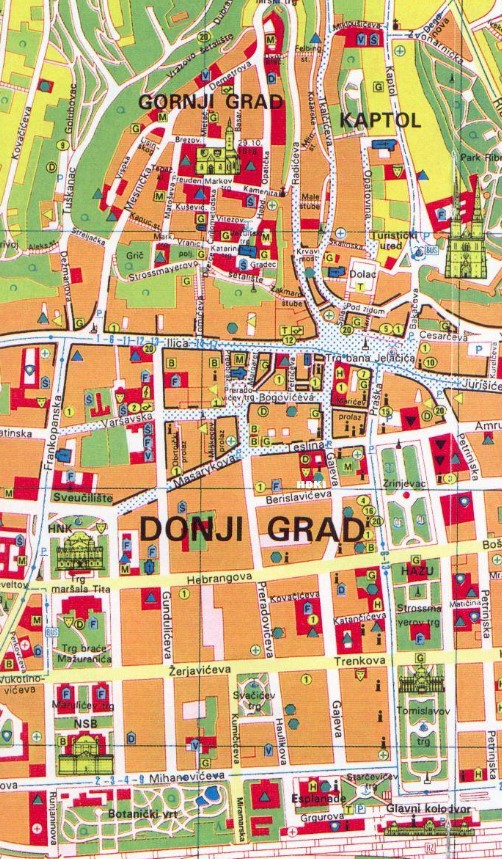Zagreb is the cultural, scientific, economic, political and administrative centre of the Republic of Croatia. Zagreb (with a population of just over 800,000), contains almost a quarter of the entire Croatian population. Over the centuries, the city has been inhabited by people from all over Europe.

It is flat and is relatively small compared to other European capitals so walking around is not too taxing.
There are lots of parks and even forests within the city limits.
For us simple tourists it is beautifully laid out in a U shape meaning if you go up one major park, across a bit and back down the other park you have pretty much ticked all the big tourist boxes.
The strict town planning scheme outlined that all streets must be straight and of the same width, and all buildings of the same type and height. The town itself is lovely, but it is a terrible state of disrepair. The main tourist walks are ok but stray just a little off the path and the neglect and graffiti become painfully evident. And they have seriously taken their toll on the city. While it is clear that attempts are being made to pull this back (scaffolding and renovations abound) for now the city looks quite derelict.
For us the obvious place to start our tour of the town was at the top end of the U which was the central railway station. An impressive building (but a rubbish train station) , directly opposite is a huge statue of Kralj Tomislav (former prince and believed ruler dating around the 9th century) on a horse and a park leading towards the Art Pavilion.



Crossing the road from the the Art Pavillion you enter the Park Josipa Jurja Strossmayera (a Croatian bishop, theologian, politician, and founder of central Croatian scientific and cultural institutions). The park is another lovely green space making up the straight part of the U but in reality is a park full of old guy statues.




Next on the U is Park Zrinjevac another green space with fountains and a meteorological column at the end that was erected in 1884.


Popping out of here you find yourself in Ban Jelacic Square. This is the main square of Zagreb and is the starting point for exploring the downtown area. The square is huge, with lovely buildings surrounding it on all four sides. The majority of buildings date back to the 19th century and feature different architectural styles: from post-modernism, Art Nouveau, and Biedermeier.
In the square is yet another very impressive statue of a dude on a horse (Count Josip Jelacic – an important Croatian politician of the 19th century). There is a very impressive copper diorama showing the old town area, also a local (Dolac) market and the usual array of retail shops and transport.



Just around the corner is the main church in town (Cathedral of the Assumption of the Blessed virgin Mary) which has been under permanent renovations for decades. In fact there is not one photo of it in its original form (without scaffolding) for many years. I found one on google images but cannot tell how long ago it looked this way. Our photos are what most people get to see.



Across the U and you find yourself at the bottom of the Lotrščak Tower and the the Grič cannon which fires every day exactly at noon, and has done for over 100 years. The tower was part of the southern gate and town defences against the Turks, built in 1266. The Zagreb Funicular is the shortest funicular in the world but also the oldest and first means of public transportation in Zagreb.



Once up the top you find yourself among a bunch of impressive buildings, museums and galleries along with the impressively roofed St. Marc Church.




Finishing off the bottom of the U you come across the Stone gate (Kamenita Vrata), a very cool horse and dragon statue and into the usual retail and tourist offerings that cannot be avoided.





With all of that done all that is left is to walk the straight part of the other side of the U. The first thing you hit is the Hrvatsko narodno kazalište (Croatian National Theatre), a tribute to Marko Marulić ( the 14th century father of Croatian literature). And of course, lots of green space along the way and finally finishing at the botanical garden.




According to the blurb, the key bits of upper town are the tucked away courtyards within the buildings. Twice a year celebrations (Secrets of Grič, and Dvorišta) open the courtyards to reveal their secrets.







Oh and as is our way, we might have taken the opportunity to sample some of the local beers. They do tend to be very tasty and along the Czech lines however, they are much more gassy which left us feeling similarly.








Horse Statues
On doing the research for this and other cities I came across the following blurb about people who are represented in statues on horses. The position of the horse indicates how the figure died in real life. If the horse has one leg raised it is meant to mean that the person died of wounds from the battlefield. If the horse had its both legs raised, the person died in combat. Lastly, if the horse had all four legs on the ground, the person died of natural causes.


